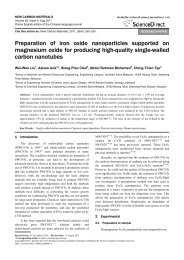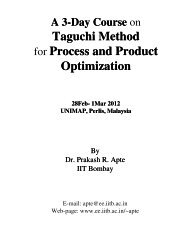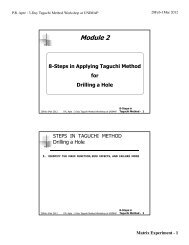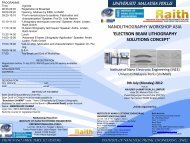TAGUCHI METHOD for DYNAMIC PROBLEMS SIGNAL - TO ...
TAGUCHI METHOD for DYNAMIC PROBLEMS SIGNAL - TO ...
TAGUCHI METHOD for DYNAMIC PROBLEMS SIGNAL - TO ...
You also want an ePaper? Increase the reach of your titles
YUMPU automatically turns print PDFs into web optimized ePapers that Google loves.
P.R. Apte : 3-Day Taguchi Method Workshop at UNIMAP 28Feb-1Mar 2012QUALITY LOSS AFTER ADJUSTMENTFirst Variance is reduced (“σ 2 term” in 'Q')Then Mean is brought on Target without disturbingthe Variance (σ 2 ) by a Scaling FactorHence the correct Quality Loss measure is Q aQ a = K σ 2 <strong>for</strong> (µ=µo) and NOTQ = K [(µ - µ o ) 2 + σ 2 ]Hence always use Q aand not Q <strong>for</strong> any estimation of quality28Feb-1Mar 2012 P.R. Apte : 3-Day Taguchi Method Workshop at UNIMAP S/N ratio (Dynamic) - 5RELATIONSHIP BETWEEN S/N RATIO AND Q a Q = K' [ (µ - µ o ) 2 + σ 2 ] If mean is µ and is to be ‘adjusted’ to µ o ,Adjust Thickness to ‘ µ o / µ’ times the earlier values Q a = K' [ (µ . {µ o / µ} - µ o ) 2 + (σ . {µ o / µ} ) 2 ] Q a = K' [ (µ o - µ o ) 2 + (σ . {µ o / µ} ) 2 ] Q a = K' [ (σ . {µ o / µ} ) 2 ]28Feb-1Mar 2012 P.R. Apte : 3-Day Taguchi Method Workshop at UNIMAP S/N ratio (Dynamic) - 6Dyn S/N Ratio - 3








